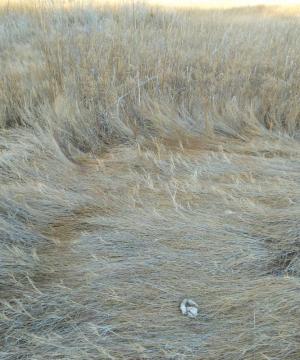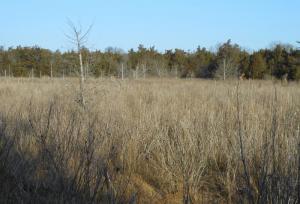According to the Old Farmer’s Almanac, sunrise Jan. 1, New Year’s Day, was 7:18 a.m.
And while a significant portion of the Cape Region population was still moving slowly from the previous night’s New Year’s Eve celebrations at that time, a group of dedicated birders were out and about participating in the Delmarva Ornithological Society’s annual Prime Hook/Cape Henlopen State Park Christmas Bird Count.
Jim White and Sally O’Byrne, both past presidents of the society, were two of those people. By 7:30 a.m., across the street from the entrance to the boat launch at the end of Pilottown Road in Lewes, they had positioned their spotting scopes facing north and were looking over Canary Creek Marsh.
The still marsh grasses were gold from the early morning sun, and the two had already been to Holland Glade Road in Rehoboth to see the Crested Caracara, a tropical falcon that looks a lot like a vulture, which had wandered a 1,000 miles from its usual homes of Texas, Florida or Arizona.
“We would have been out earlier, but last night was New Year’s Eve,” said White, a naturalist for the Delaware Nature Society, with a smile and a shrug of his shoulders.
Two men, John Stinson and Jim Flaherty of Chevy Chase, Md., rounded out the group. Both have years of experience, but described themselves as beginners compared to the two former presidents.
Nationwide, the Audubon Society started the Christmas Bird Count 117 years ago. White, who has 34 years of Christmas counts under his belt and organized the statewide efforts this year, said the counts have been happening annually in Delaware since the society was formed in 1963. There were less regular counts dating back to the 1930s, he said.
This year’s counts took place across the state, beginning Dec. 14 and running through Jan. 5, said White. The count area is done in circles, broken down into wedges of pie, and, he said, there were other birders counting in all the pieces that day. The New Year’s Day count covered Prime Hook south to Cape Henlopen State Park, and included Canary Creek Marsh, Lewes Beach and a special boat trip out to the icebreakers in the mouth of the Delaware Bay.
O’Byrne, who can boast 20 years’ worth of Christmas counts, but probably wouldn’t, was in charge of a count on New Year’s Eve that started just south of the state park, moved in and around Rehoboth, and finished south of Dewey. It was breezy and cold, said O’Byrne, who, dressed in layers and rain boots, clearly didn’t mind the weather conditions.
There were more birds out than there were Jan. 1, she said.
The group of four moved down a trail at the end of Pilottown Road, toward what remains of the old Green Hill Lighthouse and then out into Canary Creek Marsh. White would occasionally stop and imitate a screech owl in an attempt to draw other birds out of the overgrown remnants of the lighthouse and surrounding brush.
“The scrub areas are a good place for birds,” he said.
There wasn’t much success, but the group was in good spirits.
“We’re ever hopeful. We’re ever hopeful,” said O’Byrne, as she pushed off into another area of the brush by herself.
Birders count groups of species by tens or hundreds. Noticing a flock of the white-bodied snow geese moving left to right across the bright blue sky, the experienced O’Byrne quickly counts off 10 of the birds and estimates a group size of about 60.
White said the vast majority of birds fly in groups of one to 10, but the large groups of snow and Canada geese will travel in flocks well into the hundreds, and even the thousands.
After surveying a couple of the marshes’ hummocks, the group made the call to move on to Lewes Beach to see if there were any seabirds. The 2.5-mile drive took significantly longer than expected because White and O’Byrne stopped to look at every bird they saw.
“We’re real mopey,” said White, laughing, at the beach. “We’re constantly scanning back and forth.”
After about 20 minutes of spotting gulls and a few Surf Scoters, they moved to the Cape May-Lewes Ferry Terminal because the rocks that make up the Lewes Harbour’s breakwaters are visible in their high-powered scopes.
White said on a good day, someone will count close to 50 species of birds. The state record is 197 species in one day, but there are reports of more than 200, he said. “Birders love to tell stories,” he said.
In a little more than two hours of a count that lasts all day, Stinson had made note of 16 species sightings, including Double-crested cormorants, a mourning dove, black ducks, Surf Scoters, Buffleheads, a Great black-backed gull, Ring-billed gulls, a Great Blue Heron and Red-breasted Mergansers.
“There weren’t too many birds, but this is one of the best spots in Delaware to watch the sunrise,” said White.
“I would agree,” said O’Byrne.
White said Jan. 3 the final numbers from this year’s count are not available, but they will be found on the Audubon Society’s website at audubon.org. He said the numbers are collected by the national program, and entered into a database which is available to general birders and researchers. One way the data can be used is to determine the increase or decrease in bird populations over time, he said.
Chris Flood has been working for the Cape Gazette since early 2014. He currently covers Rehoboth Beach and Henlopen Acres, but has also covered Dewey Beach and the state government. He covers environmental stories, business stories and random stories on subjects he finds interesting, and he also writes a column called Choppin’ Wood that runs every other week. He’s a graduate of the University of Maine and the Landing School of Boat Building & Design.



























































